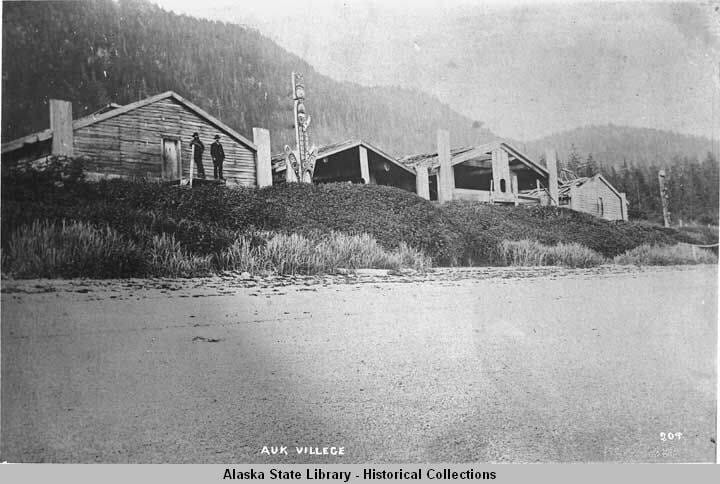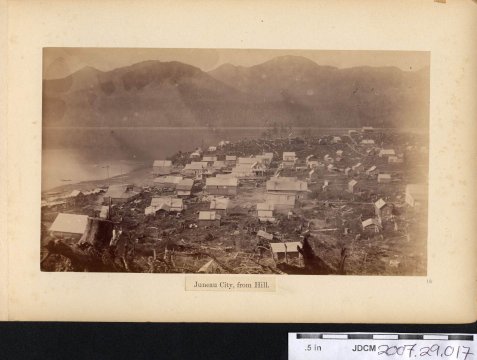Juneau History Timeline

Pre-Contact through Russian and Euroamerican Era

Early American Era: 1867 through the end of the 19th century

20th Century
Introduction
This timeline attempts to highlight local events each year in Juneau’s recorded history since its inception as a gold mining camp in 1880 and its subsequent development. Events prior to 1880 are summarized in a brief overview from Richard Carstensen’s “Natural History of Juneau Trails, a Watershed Approach, 2013,” and several other Alaska history sources. Carstensen rightly emphasizes that the Juneau area is the homeland of Tlingit peoples from the Áak’w Kwáan, and the T’aaku Kwáan, and we defer to his selection of events prior to the arrival of Euro-American settlers who established the camp and colonized the area thereafter. General time periods of Juneau’s history up through the latter 20th century are outlined in a Juneau History Preservation Plan for the City and Borough of Juneau (CBJ) in Table 1. https://juneau.org/wp-content/uploads/2020/02/Historic-Preservation-and-Cultural-Plan-FINAL-VERSION-2020.02.19.pdf. Juneau census records are summarized in Table 2. from Alaska census records at the State of Alaska Department of Labor website: https://live.laborstats.alaska.gov/cen/hist.html.
What are the criteria used for inclusion of events in this timeline? In general, events are selected that show development contributing to economic growth both short and long-term, cultural and social events that help define the times; political events or movements that affect the course of area development; natural events that disrupt otherwise “normal” development; and occasionally just plain strange, unusual, or unique events not otherwise noted in academic histories. We are greatly indebted to Robert “Bob” DeArmond as the primary source for most events 1880-1951. Reporter, author, and historian, DeArmond compiled thousands of individual notes from newspapers and other sources in that period which he shared in his weekly columns over the course of about thirty years in local Juneau publications. These can be accessed on-line: https://juneau.org/library/museum/digital-bob. From that time onward, we have much less easily-accessed material from which to draw, so it will be an ongoing process to research newspapers and compile a more complete list of events to publish here. Do feel free to contact us with your suggestions and contributions to include: juneauhistory@gmail.com .
Searches may be made within these timelines or throughout the whole website by using the search icon on the upper right of the main menu. The search function uses a keyword search, which allows you to perform a general search across multiple fields for any material in this site. Keyword searches use OR as the default connector between words (e.g. a search for China Joe will return records associated with China OR Joe). If you want to find records where both keywords are found, type in AND between the two words. To search for a specific phrase, be sure to put the phrase within quotes (e.g. “Alaska Civil Code”). You can also use the asterisk (*) as a wildcard (e.g. a search for histor* would come up with records containing history, histories, historical, etc.). Searches are not case sensitive.
Table 1 – Historic Themes, Time Periods, and Property Types for Juneau History Preservation Plan.
| Theme | Time Period | Property Types |
| Lifeways and Ethnicity – Tlingit Occupation | 1000-1741 Late Prehistoric Era | Archaeological Sites |
| Population, Exploration, and Settlement – Discovery of Gold | 1741-1867 Russian and Euroamerican Era | Historic and Archaeological Sites |
| Commerce and Economic Development – Early Gold Mining | 1867-1912 Early American Era | Mining Sites and Ruins; Commercial and Residential Buildings; Institutional and Educational Buildings; Religious and Social Buildings |
| Commerce and Economic Development – Peak Gold Mining, Beginning Territorial Government | 1912-1938 Community Building Era | Mining Sites and Ruins; Commercial and Residential Buildings; Institutional and Educational Buildings; Religious and Social Buildings |
| Transportation and Communication – End of Gold Mining, Suburban Development | 1938-1959 World War II and Early Cold War Era | Commercial and Residential Buildings; Institutional and Educational Buildings; Religious and Social Buildings; Expanded Roadways; Juneau Airport |
Table 2. Juneau area census 1880 – 2020 (1).
| Year | Total | Juneau | Glacier Highway | Auke Bay | Douglas | Douglas Island | Treadwell | Thane | Auk Villages | Taku Villages |
| 1880 | 840 | 640 | 200 | |||||||
| 1890 | 1979 | 1253 | 402 | 324 | ||||||
| 1900 | 3472 | 1864 | 825 | 522 | 261 | |||||
| 1910 | 4806 | 1644 | 1722 | 1222 | 218 | |||||
| 1920 | 4723 | 3058 | 919 | 325 | 421 | |||||
| (2)1930 | 5009 | 4043 | 289 | 593 | 16 | 68 | ||||
| (3)1940 | 7390 | 5808 | 845 | 522 | 136 | 13 | 66 | |||
| (4)1950 | 7117 | 5956 | 86 | 295 | 699 | 81 | ||||
| (5)1960 | 7921 | 6797 | 1042 | 82 | ||||||
| (6)1970 | 13556 | 6257 | 4732 | 786 | 1243 | 538 | ||||
| (7)1980 | 19528 | |||||||||
| 1990 | 26751 | |||||||||
| 2000 | 30711 | |||||||||
| 2010 | 31275 | |||||||||
| 2020 | 32255 | |||||||||
| ________________ | ||||||||||
| (1) Source: https://live.laborstats.alaska.gov/cen/hist.html | ||||||||||
| (2) 1940 census reported the 1930 population numbers as collected for 1929 | ||||||||||
| (3) 1940 census reported the 1940 population numbers as collected for 1939, added a sub-unit for AJ Camp which is included in Juneau, Glacier Highway includes Lena Beach and Tee Harbor, and a separate one for Douglas Island outside Douglas city limits, Treadwell townsite. | ||||||||||
| (4) 1950 census added Auke Bay village, dropped AJ Camp (the AJ mine closed in 1944), Douglas Island, and Treadwell, noted Lena Beach and Tee Harbor separately so left these sub-units in the Glacier Highway subdivision. | ||||||||||
| (5) 1960 census noted annexations to Juneau since 1950 (an explanation for dropping earlier census sub-units and consolidation of numbers?) | ||||||||||
| (6) 1970 census added more sub-units: Glacier highway includes Salmon Creek, Lemon Creek, Mendenhall Flats, Mendenhall Valley, and Lena Beach sub-units; Douglas Island now is North Douglas. Census area now called Greater Juneau Borough. | ||||||||||
| (7) 1980 census and thereafter report the total number for the City and Borough of Juneau, noting that the cities of Juneau and Douglas were merged with the Greater Juneau Borough (in 1970). Sub-units are not reported separately. |
Sources:
Allen, Myrna Newton. 2009. 50 Years of Facts ‘n Food. Juneau, Alaska: Capital City Celebrations Board. 111p.
Carstensen, Richard, Discovery Southeast, Juneau City & Borough, Parks & Recreation Department. 2013. Natural History of Juneau Trails, a Watershed Approach. Juneau AK. Discovery Southeast, 72 p.
Daily Alaska Empire, aka Juneau Alaska Empire, Southeast Alaska Empire, Juneau Empire – primary source for many of the other sources listed, also source of individual news articles and yearly summaries, particularly 1952 – 1999.
Digital Bob, a series of articles from columns Gastineau By-Gones, Days of Yore, and News of the Gold Camp by Bob DeArmond on the history of the Gastineau Channel area (1880 – 1951) posted on the Juneau-Douglas City Museum webpage.
Down Through the Years, compiled by R.N. DeArmond, The Alaska Journal, various issues 1978 -79.
History on the Channel, monthly articles (2013 – 2018) and This Month in Juneau History, a collection of local history snippets curated by Mary Pat Wyatt on the Friends of the Juneau-Douglas City Museum website: https://fojdcm.org/historyflash/
Juneau 1980 Centennial Calendar, Scott Foster, researcher/writer, 1980. A calendar with Juneau events from 1880 – 1980 published for the centennial of Juneau’s founding.
This Month in Alaska’s History, articles complied by R.N. DeArmond, on the Alaska History Society website: https://alaskahistoricalsociety.org/discover-alaska/this-month-in-alaska-history/
“Today in Alaskan History…” – a day-to-day reference to historic events. Compiled by The Alaskan Headliners – Michael Sakarisa, Jeff Brown, Judy Hall. 1990. A book of headline events in Alaskan history, with Juneau items used on this page.
